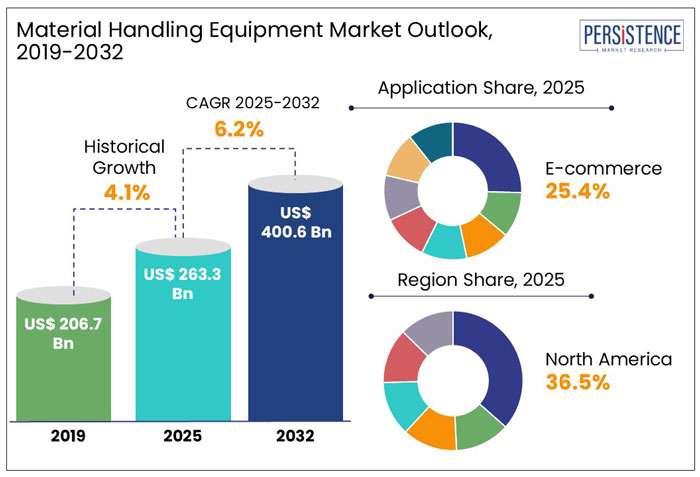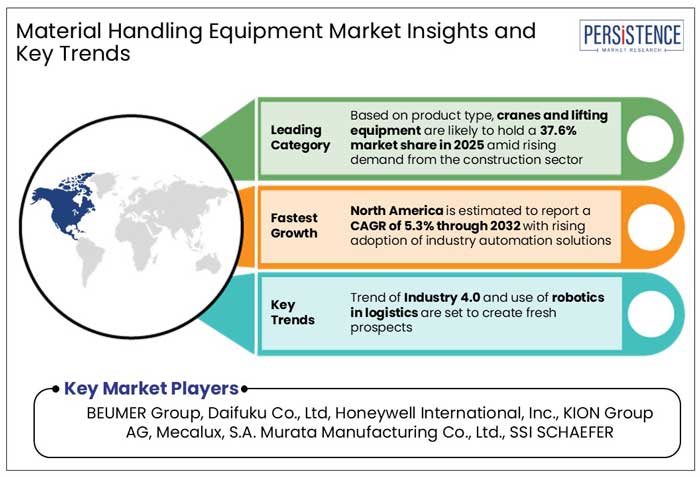Industry: Industrial Automation
Published Date: January-2025
Format: PPT*, PDF, EXCEL
Delivery Timelines: Contact Sales
Number of Pages: 187
Report ID: PMRREP33178
The global material handling equipment market is estimated to reach a size of US$ 263.3 Bn in 2025. It is predicted to rise at a CAGR of 6.2% through the assessment period to attain a value of US$ 400.6 Bn by 2032.
The material handling equipment market is estimated to be driven by rapid industrialization, increased automation demand, and improvements in Industry 4.0 technologies. Labor shortages and warehouse interruptions brought on by the epidemic have also boosted investments in robots and IoT-enabled systems, highlighting the need for automated solutions.
The rise of e-commerce, driven by platforms like Amazon and Walmart, has raised the need for sophisticated storage solutions. This has altered the industrial and logistical operations globally for worker productivity and safety.

Key Highlights of the Market
|
Market Attributes |
Key Insights |
|
Material Handling Equipment Market Size (2025E) |
US$ 263.3 Bn |
|
Projected Market Value (2032F) |
US$ 400.6 Bn |
|
Global Market Growth Rate (CAGR 2025 to 2032) |
6.2% |
|
Historical Market Growth Rate (CAGR 2019 to 2023) |
4.1% |
North America is set to maintain its dominance in the global material handling equipment market, holding around 36.5% of the share in 2025. The region is set to record a CAGR of 5.3% from 2025 to 2032, driven by automation needs in retail, manufacturing, and logistics sectors.
The post-pandemic boom in online shopping, automation, e-commerce, and technical improvements have made the U.S. the global leader, driving demand for material handling systems. For example,
Market players such as Dematic and Honeywell International are at the forefront, developing robotic systems and automated storage solutions.
Europe is poised to be a key market for material handling equipment, with the U.K. and Germany driving much of the growth. The region is set to hold a share of 28.9% of the market in 2025 and is projected to report a CAGR of 6.2% from 2025 to 2032.
The U.K. has seen substantial investments in automation and material handling solutions, especially in the retail and logistics sectors. Growth is driven by companies like Ocado Group, which heavily utilize robotics in their supply chain.
Germany, known for its robust manufacturing and automotive industries, is increasingly adopting automation solutions, with companies such as KUKA and Siemens leading innovations in robotic systems. Legislative reforms in Europe and sustainability standards, as well as capital backing for technology-driven logistics solutions, are projected to boost development.
In 2025, cranes and lifting equipment are predicted to dominate with 37.6% of the global market share due to their use in construction, logistics, and manufacturing industries. In order to provide safe and effective storage, building, and infrastructure projects drove an 8% growth in sales for cranes and industrial pallet trucks worldwide in 2023. For example,
Adoption of IoT and remote operation technologies ensures the continued dominance of cranes and lifting equipment in material handling.
The e-commerce sector is projected to account for 25.4% of the material handling equipment market share in 2025. It is driven by the penetration of online shopping platforms, efficient transportation, and demand for fast order fulfillment.
Order picker forklifts and platform trucks are in high demand owing to the expansion of logistics operations by big companies like Amazon, Alibaba, and Walmart. For example,
Rising emphasis on speed, precision, and scalability in e-commerce logistics is driving growth of the material handling equipment market.
The global e-commerce growth is driving a surge in demand for unique material handling equipment. Warehouse automation and robotics are transforming the industry, and the manufacturing sector is developing, leading to increased demand for efficient material movement solutions.
The adoption of IoT and smart technologies in logistics and supply chain management is also driving investment in unique equipment. Expansion of cold chain and pharmaceutical logistics necessitates specialized equipment requirements. For example,
Key technologies include autonomous mobile robots, IoT-enabled tracking systems, predictive maintenance technologies, and energy-efficient equipment designs. These are estimated to boost the supply chain operations of the logistics industry.

The global material handling machinery market recorded a CAGR of 4.1% in the historical period from 2019 to 2023. Demand for material handling equipment in end-use industries increased, but COVID-19 restrictions led to a decline in sales. Factory automation is replacing human labor, increasing demand and optimizing production processes, with autonomous robots and the IoT playing crucial roles. For instance,
Demand for material handling tools is estimated to record a considerable CAGR of 6.2% during the forecast period between 2025 and 2032.
Rising E-commerce Operations to Drive Demand
Sales of sophisticated material handling equipment are estimated to reach US$ 6.3 Tn in 2024 due to the rise of global e-commerce operations, which is driving automation in warehouses and distribution hubs. Amazon employs over 500,000 robots in its global fulfillment centers as of 2023, demonstrating the popularity of technologies like automated guided vehicles and robotic picking systems.
Demand for material handling solutions is pronounced in high-demand markets like the U.S., China, and India, where e-commerce growth rates exceed 20% annually. Real-time inventory tracking, predictive maintenance, and scalability requirements are just a few of the ways that AI and IoT technologies are transforming inventory management for the e-commerce industry.
Automation and Robotics in Warehouse Management
Warehouse automation and robotics are transforming material handling technology, with key players like Daifuku, Dematic, and Honeywell delivering advanced solutions. For example,
Growing reliance on automation in supply chain management is evident through Walmart's implementation of automation technologies, such as collaborative robots (cobots) and AI-driven predictive analytics. These innovations aim to enhance e-commerce throughput, reduce labor costs, and minimize errors.
High Initial Cost Impedes Adoption among SMEs
The progress of the market is being hindered by the high initial cost of purchasing and maintaining material handling equipment. It keeps small and medium-sized businesses from competing with multinational behemoths.
Adoption by small and medium-sized businesses is restricted by implementation obstacles for sophisticated automated systems, which vary from US$ 500 Th to US$2 Mn. Further impeding market growth is the fact that 30% of businesses have difficulties integrating new material handling systems with their current infrastructure. Technological intricacy of the sector and these variables make it extremely difficult for small and medium-sized enterprises to expand their market share.
Integration of IoT and Smart Technologies
IoT and smart technologies are altering logistics and supply chain management, enhancing efficiency, transparency, and decision-making, with DHL and FedEx leading the way.
Smart technologies such as predictive analytics and AI are streamlining logistics, helping companies optimize routes and reduce fuel consumption. As e-commerce continues to expand, IoT adoption in logistics is set to play a pivotal role in meeting growing consumer demands.
Boom of Cold Chain and Pharma Logistics
In recent years, the need for specialist temperature-controlled material handling equipment has grown to about 70% due to the expansion of cold chain and pharmaceutical logistics. Companies are investing heavily in unique solutions to maintain product integrity during transit. Pharmaceutical giants like Pfizer and Moderna rely on ultra-cold storage and precise material handling for vaccine distribution, especially post-pandemic.
In the food logistics sector, companies like Americold are enhancing their temperature-controlled operations to cater to the demand for fresh and frozen food. IoT-enabled devices and real-time monitoring systems are being integrated to ensure compliance with stringent regulations, such as the FDA’s Food Safety Modernization Act (FSMA), driving innovation in cold chain material handling.
Key participants in the global material handling equipment market are enhancing their capabilities and resources to address the surging demand in the industry. They are strategically developing new manufacturing facilities and exploring partnership and joint venture opportunities to bolster their operational strengths. These innovative tools are designed to assist organizations in managing routine shipments and handling large commodities with greater efficiency and effectiveness.
In order to stay ahead of the competition and stay relevant in a market that is always changing, businesses in competitive markets are using both inorganic growth strategies. This mainly includes mergers and acquisitions as well as organic development methods, such as product expansion and operational improvements.
Recent Industry Developments
|
Attributes |
Details |
|
Forecast Period |
2025 to 2032 |
|
Historical Data Available for |
2019 to 2023 |
|
Market Analysis |
US$ Billion for Value |
|
Key Regions Covered |
|
|
Key Market Segments Covered |
|
|
Key Companies Profiled in the Report |
|
|
Report Coverage |
|
|
Customization and Pricing |
Available upon request |
By Product Type
By Application
By Region
To know more about delivery timeline for this report Contact Sales

The market size is set to reach US$ 400.6 Bn by 2032.
One needs to understand warehouse space, consider ceiling height, rack type, aisle width, and preferred operation type for equipment use.
In 2025, North America is set to attain a market share of 36.5%.
In 2025, the market is estimated to be valued at US$ 263.3 Bn.
BEUMER Group, Daifuku Co., Ltd., Honeywell International, Inc., and KION Group AG are a few key players.